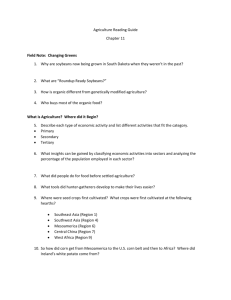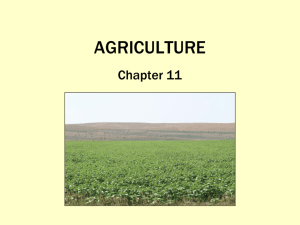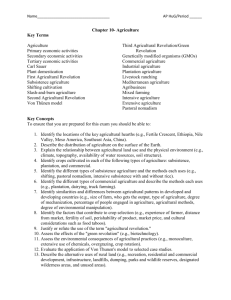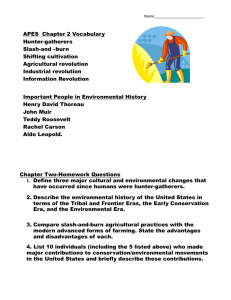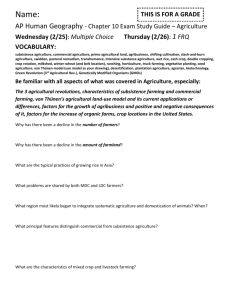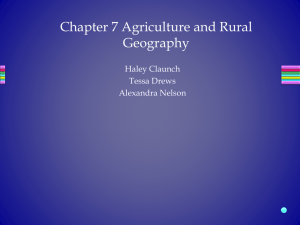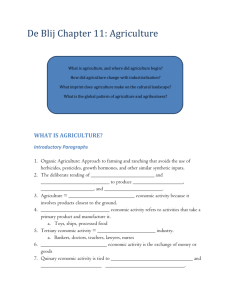Agriculture
advertisement
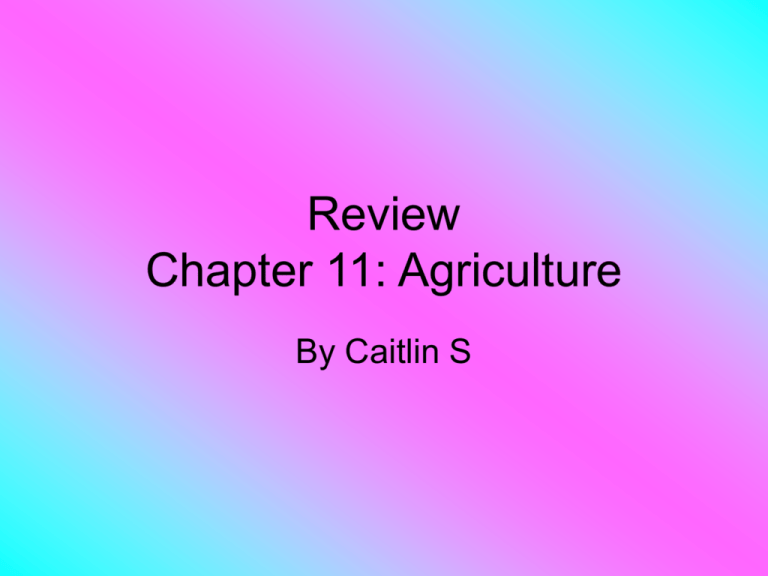
Review Chapter 11: Agriculture By Caitlin S What is Agriculture? • Agriculture: The purposeful tending of crops and livestock in order to produce food and fiber. • About half of the grains grown in the United States are consumed by people • The other half is utilized for livestock feed Economic Activities • Primary Economic Activities: Economic activity concerned with the direct extraction of natural resources from the environment-such as mining, fishing, lumbering, and especially agriculture. • Secondary Economic Activities: Economic activity involving the processing of raw materials and their transformation into the finished industrial products; the manufacturing sector. Economic Activities (cont.) • Tertiary Economic Activities: Economic activity associated with the provision of services-such as transportation, banking, retailing, education, and routine office-based jobs. • Quaternary Economic Activities: Service sector industries concerned with the collection, processing, and manipulation of information and capital. Examples include finance, administration, insurance, and legal services. Economic Activities (cont.) • Quinary Economic Activities: Service sector industries that require a high level of specialized knowledge or technical skill. Examples include scientific research and high-level management. Hunters and Gatherers • Before modern day agriculture, there were hunters and gatherers • Differed based on region • American Indians near the Pacific Ocean fished for salmon • Those in northern North America migrated along with caribou herds First Agricultural Revolution • Dates back 10,000 years • Time when both plant and animal domestication originated • Plant Domestication: Genetic modification of a plant such that its reproductive success depends on human intervention. • Animal Domestication: Genetic modification of an animal such that it is rendered more amenable to human control. Subsistence Agriculture • Subsistence Agriculture: Growing only enough food to survive. • Subsistence farmers utilize the natural environment • Farmers that practice this often live in South and Middle America, and South and Southeast Asia • When a surplus occurs, it is shared with other members of the community Second Agricultural Revolution • Second Agricultural Revolution: Witnessed improved methods of cultivation, harvesting, and storage of farm produce • Benefited from the Industrial Revolution • Composed of a series of innovations, improvements and techniques. • Moved agriculture beyond the levels of subsistence Von Thünen’s Model • Described as the first effort to analyze the spatial character of economic character. Third Agricultural Revolution/ Green Revolution • Began as early as the 1930s • Currently in progress • Agricultural scientists began to manipulate seeds of crops in a process known as genetic modification • Genetically modified organisms (GMOs): Crops that carry new traits that have been inserted through advanced genetic engineering methods. Landownership *Rectangular Survey System/Township and Range: A rectangular land division scheme designed by Thomas Jefferson to disperse settlers evenly across farmlands of the U.S. interior *Appears with a checkerboard pattern across agricultural fields *Is the most popular system in the United States today Landownership (cont.) *Metes and Bounds Survey: A system that relies on descriptions of the land ownership and natural features such as streams or trees. *The U.S. abandoned this technique in favor of the rectangular survey system *Longlot Survey System: System in which land is divided into narrow parcels. Villages • Traditional farm villages are common today in India, Sub-Saharan Africa, China and Southeast Asia • These villages often rely on subsistence agriculture • Europe contains villages that are clustered on hilltops • Modern villages are often arranged in a grid pattern Types of Agriculture • Commercial Agriculture: Large scale farming and ranching operations that employ vast land bases, large mechanized equipment, factory-type labor forces and the latest technology. • Monoculture: Dependence on a single agricultural commodity. • Ex. Sri Lanka is known for tea and Ghana is known for cocoa Types of Agriculture (cont.) • Plantation Agriculture: When cash crops are grown on large estates (an example of a cash crop is sugarcane). • Mediterranean Agriculture: Specialized farming that occurs only in areas where the dry-summer Mediterranean climate prevails. Illegal Drugs • There is a high demand for illegal drugs, which makes them classify as cash crops • Coca (which is used to make cocaine) is grown in Colombia, Peru and Bolivia • Heroin and opium come from opium poppy plants, grown in Southeast and Southwest Asia • Over 90% of illegal opium production worldwide comes from Afghanistan and Myanmar (according to the UN Office for Drug Control and Crime Prevention Climate Classification System • Köppen Climate Classification System: A system created by Wladimir Köppen to classify the world’s climates based on temperature and precipitation • His system goes on to create climate regions • Climate Regions: areas with similar climatic characteristics Environmental Impacts • Chemicals, such as pesticides and growth hormones for plants and livestock, impact the environment • Deforestation has also increased over the years as agriculture is expanding • Droughts also occur, making less vegetation grow • Desertification: when humans destroy soil vegetation through overuse of land for livestock grazing or crop production Agribusiness • Agribusiness: General term for the businesses that provide the vast array of goods and services that support the agriculture industry • It serves to connect local farms with a spatially extensive web of production and exchange


